
Pilosella aurantiaca is a perennial flowering plant in the daisy family Asteraceae that is native to alpine regions of central and southern Europe, where it is protected in several regions.

Hieracium , known by the common name hawkweed and classically as hierakion, is a genus of the sunflower (Helianthus) family Asteraceae), and closely related to dandelion (Taraxacum), chicory (Cichorium), prickly lettuce (Lactuca) and sow thistle (Sonchus), which are part of the tribe Cichorieae. Hawkweeds, with their 10,000+ recorded species and subspecies, do their part to make Asteraceae the second largest family of flowers. Some botanists group all these species or subspecies into approximately 800 accepted species, while others prefer to accept several thousand species. Since most hawkweeds reproduce exclusively asexually by means of seeds that are genetically identical to their mother plant, clones or populations that consist of genetically identical plants are formed and some botanists prefer to accept these clones as good species whereas others try to group them into a few hundred more broadly defined species. What is here treated as the single genus Hieracium is now treated by most European experts as two different genera, Hieracium and Pilosella, with species such as Hieracium pilosella, Hieracium floribundum and Hieracium aurantiacum referred to the latter genus. Many members of the genus Pilosella reproduce both by stolons and by seeds, whereas true Hieracium species reproduce only by seeds. In Pilosella, many individual plants are capable of forming both normal sexual and asexual (apomictic) seeds, whereas individual plants of Hieracium only produce one kind of seeds. Another difference is that all species of Pilosella have leaves with smooth (entire) margins whereas most species of Hieracium have distinctly dentate to deeply cut or divided leaves.
A dry roadside dotted with small, ¾ inch red orange flowers, interspersed with very similar yellow ones, and often the white of daisies, is a good sign that you are in Hawkweed country.

Ageratum is a genus of 40 to 60 tropical and warm temperate flowering annuals and perennials from the family Asteraceae, tribe Eupatorieae. Most species are native to Central America and Mexico but four are native to the United States.

Pilosella officinarum, known as mouse-ear hawkweed, is a yellow-flowered species of flowering plant in the daisy family Asteraceae, native to Europe and northern Asia. It produces single, lemon-coloured inflorescences. Like most hawkweed species, it is highly variable and is a member of a species complex of several dozens of subspecies and hundreds of varieties and forms. It is an allelopathic plant.

Pilosella is a genus of flowering plants in the family Asteraceae. Some sources include it within the genus Hieracium.
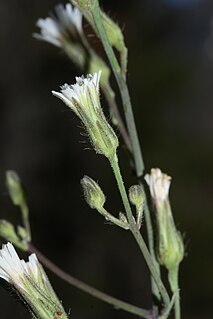
Pilosella albiflora is a common and widespread North American plant in the sunflower family, known by the names white hawkweed and white-flowered hawkweed.

Pilosella caespitosa is like several other Pilosella species and has a similar appearance to many of the hawkweeds.
Pilosella levieri is a species of flowering plant in the daisy family Asteraceae.
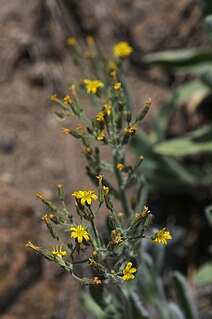
Pilosella horrida, known as the prickly hawkweed or shaggy hawkweed, gets its name from the long, dense, shaggy white to brown hairs (trichomes) which cover all of the plant parts of this plant species. The species is native to Oregon, California, and Nevada in the western United States.
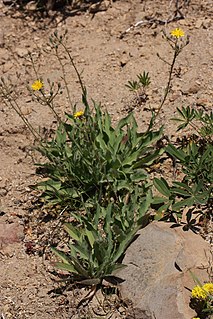
Pilosella scouleri is a North American species of flowering plant in the dandelion tribe within the sunflower family. It is known as Scouler's woollyweed. It is native to western North America, from British Columbia and Alberta in Canada, south to northern California and Utah in the United States.

Helminthotheca echioides, known as bristly oxtongue, is a stiff annual or biennial herb native to Europe and North Africa. It was traditionally used as an antihelminthic treatment.

Crombrugghia tristis is a moth of the family Pterophoridae. It is found in most of Europe, except the Benelux, Great Britain, Ireland and Scandinavia. It is also known from southern Siberia, Asia Minor and central Asia. The habitat consists of sandy areas overgrown with Hieracium.

Oenothera pilosella is a species of flowering plant in the evening primrose family known by the common name meadow evening primrose. It is native to the United States and eastern Canada.
Pilosella floribunda is a species of noxious and herbaceous perennial plant from family Asteraceae that is known in Europe and can also be found in United States and Canada. It was believed that it was a hybrid of Pilosella caespitosa (Hieracium caespitosum and Pilosella lactucella.
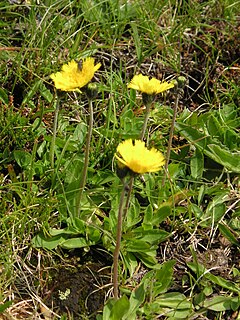
Pilosella lactucella is a species of perennial plant from the family Asteraceae, found in Europe, New York and Nova Scotia (Canada). It is 9–20 centimetres (3.5–7.9 in) in height, with stems from 1–2 millimetres (0.039–0.079 in) wide. The leaves are spatula shaped and 5–8 centimetres (2.0–3.1 in) wide. The flowers bloom from May to July, the heads of which are 2–5 centimetres (0.79–1.97 in) tall. It was once described by Carl Linnaeus as Hieracium auricula and Pilosella auricula, but was recategorized by A. E. Roland and M. Zinck in 1998.
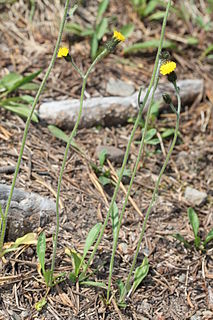
Pilosella tristis is a North American species known by the common name woolly hawkweed. It is widespread across western Canada and the western United States from Alaska, Yukon, and Northwest Territories south as far as California and New Mexico.
Pilosella abscissa is a plant species in the dandelion tribe within the sunflower family. It is considered to be native to the southwestern United States, Mexico and Central America.
Pilosella flagellaris is a European plant species in the dandelion tribe within the sunflower family. It is native to Europe but naturalized in scattered locations in the United States and Canada.
Pilosella friesii – not to be confused with the European P. schultesii – is a North American plant species in the dandelion tribe within the sunflower family. It is widespread across much of Mexico with a few populations in Guatemala and western Texas.
Vernonia echioides is a species of perennial plant in the family Asteraceae. It is native to Brazil and Argentina.












